Main Model

Laryngeal ventricle

Interior of Larynx
The laryngeal cavity extends from the laryngeal inlet, through which it communicates with the laryngopharynx, to the level of the inferior border of the cricoid cartilage. Here the laryngeal cavity is continuous with the cavity of the trachea. The laryngeal cavity includes the:
• Laryngeal vestibule: between the laryngeal inlet and the vestibular folds.
• Middle part of the laryngeal cavity: the central cavity (airway) between the vestibular and vocal folds.
• Laryngeal ventricle: recesses extending laterally from the middle part of the laryngeal cavity between vestibular and vocal folds. The laryngeal saccule is a blind pocket opening into each ventricle that is lined with mucosal glands.
• Infraglottic cavity: the inferior cavity of the larynx between the vocal folds and the inferior border of the cricoid cartilage, where it is continuous with the lumen of the trachea.
The vocal folds control sound production. The apex of each wedge-shaped fold projects medially into the laryngeal cavity. Each vocal fold contains a:
• Vocal ligament, consisting of thickened elastic tissue that is the medial free edge of the conus elasticus.
• Vocalis muscle, composed of exceptionally fine muscle fibers immediately lateral to and terminating at intervals relative to the length of the vocal ligaments.
The vocal folds are the sharp-edged folds of mucous membrane overlying and incorporating the vocal ligaments and the thyro-arytenoid muscles. They are the source of the sounds (tone) that come from the larynx. These folds produce audible vibrations when their free margins are closely (but not tightly) apposed during phonation, and air is forcibly expired intermittently. The vocal folds also serve as the main inspiratory sphincter of the larynx when they are tightly closed. Complete adduction of the folds forms an effective sphincter that prevents entry of air.
The glottis (the vocal apparatus of the larynx) makes up the vocal folds and processes, together with the rima glottidis, the aperture between the vocal folds. The shape of the rima (Latin slit) varies according to the position of the vocal folds. During ordinary breathing, the rima is narrow and wedge shaped; during forced respiration, it is wide and trapezoidal in shape. The rima glottidis is slitlike when the vocal folds are closely approximated during phonation. Variation in the tension and length of the vocal folds, in the width of the rima glottidis, and in the intensity of the expiratory effort produces changes in the pitch of the voice. The lower range of pitch of the voice of postpubertal males results from the greater length of the vocal folds.
The vestibular folds, extending between the thyroid and the arytenoid cartilages, play little or no part in voice production; they are protective in function. They consist of two thick folds of mucous membrane enclosing the vestibular ligaments. The space between these ligaments is the rima vestibuli. The lateral recesses between the vocal and the vestibular folds are the laryngeal ventricles.